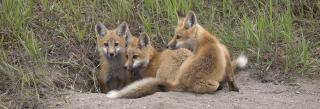 |
| Fact Sheet |
| Scientific Name |
Vulpes vulpes |
| Description |
Red fox are appropriately named for their often reddish coloration. They are a slender canine with pointed ears and nose, slender legs and a bushy tail that is nearly as long as the body. Typically, their long hair is pale to dark red on their neck, back, sides and tail, with whitish-gray chin and belly, black lower legs and ears, and a whitetipped tail. Rare color variations do occur and are often referred to as a "cross" or "silver" fox. |
Tracks |
Front foot larger than rear Front–2-1/4" L, 1-3/4" W Rear– 2" L, 1" W Walking stride: 8" - 12" |
| Total Length |
30-57 inches |
| Weight |
7-25 pounds |
| Habitat |
Red fox are known to use a wide variety of habitats including prairies, forests, agricultural fields and urban areas. Their distribution and density is believed to be limited by competition with and avoidance of coyotes. |
| Breeding Season |
January-February |
| Gestation Period |
51-53 days |
| Litter Size |
1-13 (average 5 |
| Social Aspects |
Red fox form a mated pair to raise young. They are territorial and home ranges of family groups rarely overlap. |
| Status |
Red fox can be found throughout North Dakota, but are more prevalent east of the Missouri River. Currently, there is a year-round season for fox. |
| Food Habits |
Red fox are omnivorous, and their primary food items are mice, voles, rabbits, ground squirrels, eggs, birds, fruit, insects and carrion. |
| Fun Facts |
Red fox are the most widely distributed carnivore in the world, ranging over North America, Europe, Asia and Australia. Red fox are believed to be native to the northern boreal forests of North America, but today most are genetic descendants of red fox that were introduced into the United States by European settlers. |


